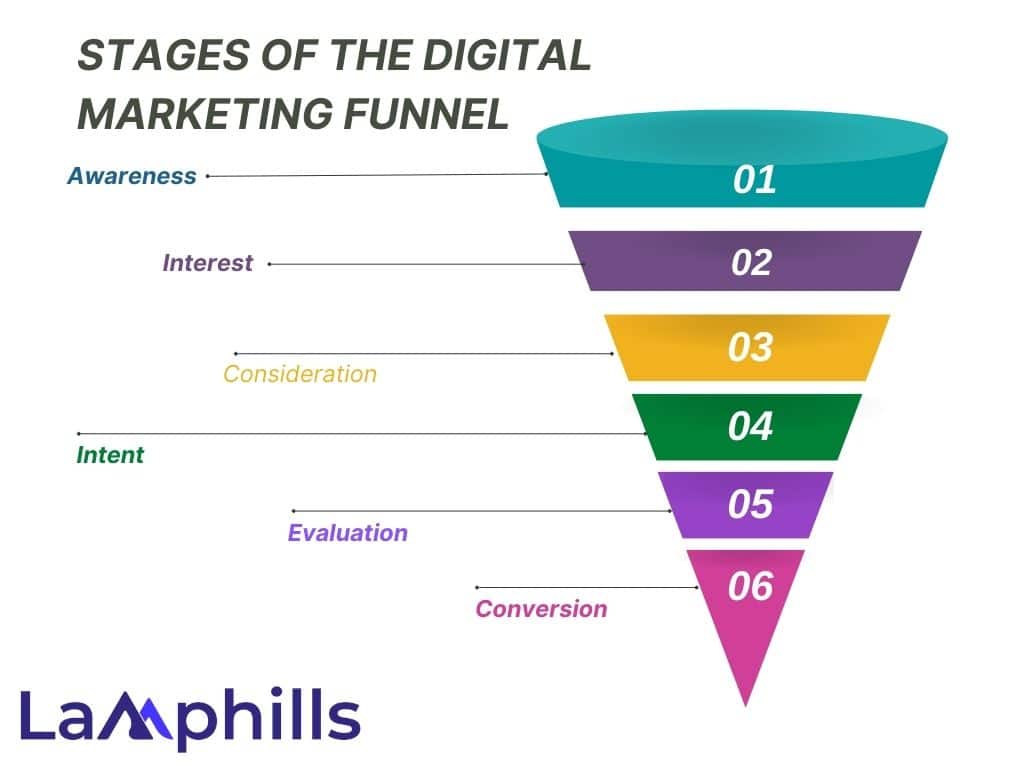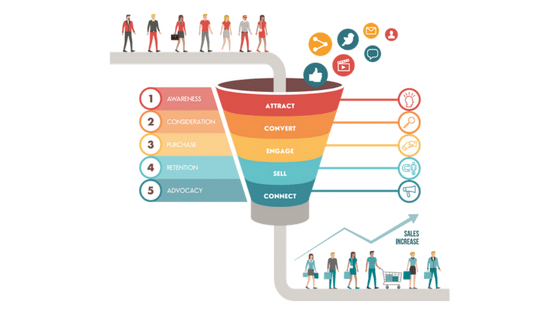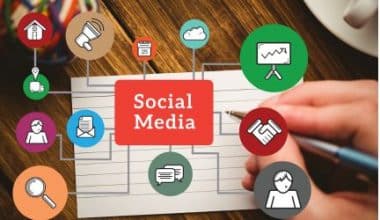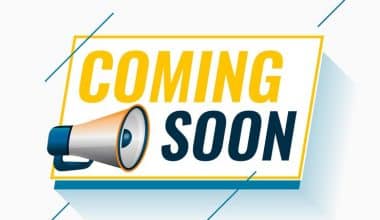I recall the first time I learned about the digital marketing funnel. I was just starting out in digital marketing, keen to increase my sales and subscriber base. Back then, the concept seemed both intriguing and intimidating. I spent numerous hours researching, testing, and fine-tuning my strategy, aiming to grasp this critical component of marketing. Here, I’ll share my experiences and thoughts with you in this thorough guide on Digital Marketing Funnel Mastery: The A-Z Training to Increase Sales and Subscribers.
What is a Digital Marketing Funnel?
A buy funnel (sometimes called a sales funnel or a marketing funnel) is a graphic representation of a customer’s path to acquiring a product or service. The funnel normally has four stages:
- Awareness: The customer knows about your product or service.
- Interest: The buyer indicates interest in a specific type of product.
- Consideration: The customer investigates the products on offer.
- Action: The customer makes a purchase.
The digital marketing funnel extends these ideas to digital marketing, following a customer’s journey through a brand’s online marketing channels until they make a purchase.
Here’s how a customer would move through the same four stages of the digital marketing funnel:
- Awareness: Also called “top of the funnel” (TOFU). The customer learns about your company through organic search, social media, email, or links from other websites.
- Interest: Also referred to as “middle of the funnel” (MOFU). The customer discovers what your brand has to offer via your website or social media material.
- Consideration: Also called “bottom of the funnel” (BOFU). The customer spends a little more time investigating your company, reading internet reviews, viewing YouTube videos, and subscribing to your email list.
- Action: The customer makes a purchase.
Read Also: Key Roles of Public Relations In Marketing
The digital marketing funnel, which was formerly separated into four key stages—Awareness, Interest, Consideration, and Purchase—has grown to become more subtle and thorough. It is now broken down into multiple stages: awareness, interest, consideration, intent, evaluation, and purchase. Each stage necessitates distinct methods and approaches to get prospects closer to conversion.
Understanding the extended funnel enables marketers to build more targeted and effective campaigns, ensuring that potential customers are nurtured and guided through each stage of their purchasing journey with precision and care.
Many digital marketers incorporate customer relationship-building and retention into their digital marketing funnels to turn these clients into long-term customers. Providing your consumers with great post-sale experiences, from customer support to ongoing brand communication, will increase their likelihood of sticking with you in the long run.
Key Takeaways
- The digital marketing funnel maps out the customer journey from awareness to purchase, providing a structured approach to convert prospects into loyal customers.
- Each stage of the funnel—Awareness, Interest, Consideration, Intent, Evaluation, and Purchase—requires specific strategies to effectively move prospects closer to conversion.
- Understanding the digital marketing funnel allows marketers to create targeted campaigns, enhancing segmentation, lead generation, and resource allocation for better results.
- Personalized engagement at each funnel stage, such as through webinars, case studies, and retargeting ads, significantly improves trust and conversion rates.
- A customizable digital marketing funnel template helps streamline efforts, track key metrics, and optimize strategies for maximum impact and efficiency.
Why is Digital Marketing Funnel Important?
The digital marketing funnel can help businesses in the following ways:
#1. Better segmentation
The digital marketing funnel can lead to improved segmentation of your marketing activities, allowing you to give more relevant material to buyers at various stages of the buying cycle.
#2. Improved lead generation
Precise marketing operations generate more qualified leads at the bottom of the funnel, making conversions much easier. A successful funnel provides value, not a hard pitch.
#3. Better utilization of firm resources
The digital marketing funnel directs your digital marketing team, allowing them to develop accurate content for your customers. This way, you won’t waste time and effort on ineffective marketing campaigns.
As you can see, developing a digital marketing funnel is a critical component of any digital marketing plan, allowing you to nurture customers from awareness to action and beyond.
Stages of the Digital Marketing Funnel

Mastering the digital marketing funnel is essential for converting leads into loyal consumers. Here’s an in-depth look at each level of the funnel, as well as methods and personal insights to help you maximize your results.
#1. Awareness
At this stage, the primary purpose is to raise awareness of your brand and what it has to offer. This is where you use a wide net to attract as many relevant prospects as possible. Content marketing is especially beneficial in this situation since it allows you to give useful information that addresses your target audience’s pain points. Creating blog posts, infographics, and social media updates that address popular queries can help increase visitors to your site. SEO makes your content discoverable by search engines, however paid advertising allows you to reach a larger audience quickly.
When I first started, I concentrated primarily on content marketing. By writing useful blog pieces and posting them on social media, I was able to drive a lot of traffic to my website. According to HubSpot, firms that blog attract 55% more website visitors than those that do not. This initial rush of traffic was critical in expanding my audience base.
#2. Interest
Once you’ve captivated your audience’s attention, the following stage is to engage them and pique their interest in your products. Email marketing is a strong tool for nurturing leads with personalized content. Webinars provide an interactive forum for demonstrating your skills and answering inquiries in real-time. Ebooks and educational films provide detailed insights into your products or services, assisting prospects in understanding their benefits.
Hosting a webinar was a game changer for me. It enabled me to contact potential consumers directly and answer their inquiries in real time. After each webinar, I saw a 20% increase in email subscribers. This direct interaction increased trust and established me as an authority in my industry.
#3. Consideration
Prospects who are in the consideration stage are aware of your brand and interested in what you have to offer, but they require more information before making a choice. Case studies and testimonials are extremely powerful because they give social proof and demonstrate real-world uses for your products or services. Offering free trials or demos allows prospects to gain direct familiarity with your product. Detailed product descriptions and specifications help to answer any questions they may have regarding your offers.
According to the Demand Gen Report, 47% of buyers looked at three to five pieces of content before speaking with a sales representative, emphasizing the significance of giving enough information to assist prospects in making an informed decision.
#4. Intent
Prospects are at the point of making a purchasing choice. Personalized emails can answer specific problems or queries they may have, whereas retargeting ads remind them of the benefits your product or service provides. Special incentives, such as discounts or limited-time specials, can be the final push customers require to convert.
I once created a retargeting ad campaign for people who abandoned their shopping carts. By offering a limited-time discount, I was able to recoup 30% of lost sales in just one week. This method enhanced conversions while also re-engaging potential consumers.
#5. Evaluation
During the evaluation stage, prospects weigh their options and may have final objections or worries. Live demos and consultations can provide hands-on experience and clarify any remaining questions. Clear call-to-actions (CTAs) help prospects navigate the purchasing process, making it simple and hassle-free.
According to an Accenture survey, 75% of consumers are more likely to buy from a brand that knows their name, recommends options based on previous purchases, or is familiar with their purchasing history. Personalization during this stage can considerably improve the purchasing experience.
#6. Purchase (Conversion)
The final stage of the funnel is where the conversion occurs. A simple checkout procedure with fewer stages lowers friction and cart abandonment. Offering several payment alternatives appeals to a variety of customer preferences. Post-purchase follow-ups, such as thank-you emails and satisfaction surveys, promote a favorable experience and encourage repeat business.
My website’s cart abandonment rates were considerably lowered when I implemented a streamlined checkout procedure with fewer stages. According to the Baymard Institute, the average cart abandonment rate is 69.8%, emphasizing the significance of a smooth checkout process. By streamlining the process, I was able to increase conversions and customer happiness.
Traditional vs. Digital Marketing Funnel
A normal marketing funnel follows a linear development from one phase to the next. A customer progresses through the funnel based on certain interactions.
A digital marketing funnel differs in that it focuses on qualifying and segmenting leads before assigning them to one of several funnels. Each funnel will be geared toward a unique type of buyer.
It frequently resembles an hourglass, with several paths branching off in different directions. This procedure may take longer to complete, but it guarantees that the marketing and sales teams are consistent in their messaging. In fact, there is a higher chance of converting leads into consumers.
Overall, a digital marketing funnel seeks to reduce turnover. Thus, it saves time and resources on leads who have no intention of converting. The more tailored the funnels are, the easier it is for salespeople to close deals and boost the company’s profits.
Digital Marketing Funnel for B2B
Developing a marketing strategy for a B2B company is difficult because the buyer is another business, not a person. In most cases, numerous people are involved at different stages of the funnel, thus the marketing and sales teams must appeal to a wide range of personalities and demands.
Typically, the individual who indicates interest in the product does not make the ultimate purchase decision, therefore a B2B marketing funnel must manage this disparity.
Realistically, a good B2B marketing funnel will include interactions with several members of the client’s organization, such as the CEO, department manager, supervisors, accountants, and others.
By bringing these people into the funnel from the start, the marketing team can produce materials that appeal to everyone involved, not just the first point of contact.
Digital Marketing Funnel for B2C
The AIDA form of a marketing funnel is developed with the customer in mind, making it ideal for B2C sales. Because the individual is both the point of contact and the decision maker, marketers only need to appeal to one person, rather than several people within a larger organization.
As a result, it’s best to develop several marketing funnels for different demographics or user IDs. This way, the marketing and sales teams can guarantee they’re both working from the same blueprint and tackling the same issues to advance the lead through the funnel.
So, rather than creating a network of distinct channels for each segment, it is best to simply design a separate funnel.
Click Funnel Marketing
A traditional marketing funnel involves a lead interacting with many pieces of content across multiple channels before deciding to contact your company.
With a click funnel, the procedure is faster and more efficient. Instead of having many encounters across different periods, a lead will progress through the funnel until they are ready to contact a salesman.
A click funnel example could look like this:
- Ad: A user encounters an advertisement, such as on social media or through a search engine.
- Landing Page: After clicking on the ad, the user is directed to a landing page with additional information about the product or service. A user may navigate through several landing pages, but they will always lead to the same destination: a conversion page.
- Call to Action: The user will notice a specific call to action, such as subscribing to a list or seeing a product listing. From there, the user has the option of making a purchase or contacting a salesperson to proceed.
To help you enhance your conversion rates and optimize your digital marketing efforts, be sure to check out our post on landing page optimization tools.
Content Marketing Funnel
As previously stated, a marketing funnel primarily focuses on interactions between leads and information aimed to pique their interest in your product or service.
A content marketing funnel embraces this approach by creating distinct content pieces for each step of the funnel. If a segment mentions social media networks, your marketing team can generate material to promote on these platforms.
Similarly, if a segment includes blog posts, the marketing team can create individual pieces to address specific client requirements or problems at that stage of the funnel.
Content marketing is more labor-intensive, but with a service like Linkmie, you can connect with world-class authors from all industries who can create one-of-a-kind pieces to help convert leads into buyers.
How to Build an Effective Digital Marketing Funnel
Even though it is critical to the success of your Digital Marketing plan, not everyone understands what is required to construct a funnel for your firm.
The first stage is simple: set a goal for your actions, such as increasing sales or your business’s Return On Investment (ROI). In short, a goal to be met.
Then you must structure the funnel by specifying the steps involved in the sales cycle.
Creating a visual representation of the stages makes it easy to choose which model is appropriate for your organization.
Now that you’ve developed your funnel, you can figure out what you need to do to generate the desired traffic at each stage.
In this approach, your target audience will be influenced by content that is appropriate for their level of understanding.
What Form of Content Works Best at Each Stage of the Funnel?
Understanding how the Digital Marketing funnel works will help you make more accurate decisions, make better use of your company’s resources, and influence users who may become customers of your business.
That is why we segregated the most appropriate sort of information for each level.
#1. Awareness
Whatever Digital Marketing funnel you choose for your company, the awareness stage should always come first.
After all, nothing works if the consumer is unfamiliar with your company. What better method to accomplish this than to advertise and promote your brand on the appropriate platforms?
On average, Google receives approximately 75,000 searches each second. In other words, you must be present and, more importantly, seen on this channel.
As a result, the goal is to begin your Content Marketing strategy by increasing your visibility through Search Engine Optimization (SEO) approaches or even sponsored adverts in search engines.
The critical thing is that the user inputs a specific keyword and your page appears in the top results.
At this stage, the goal is to create material that grabs viewers’ attention, such as informative films and infographics. Now it’s time to generate as much traffic as feasible.
On your blog, focus on materials aimed at people who are unfamiliar with your organization or the notion that you can provide solutions to some of their difficulties.
The formula for this phase is simple: to enhance visibility, the company should focus on topics that appeal to a large number of people and are relevant to her.
To accomplish so, they can conduct research on a head-tail term with thousands of searches every month.
#2. Discovery
In this following step, it is best to focus on creating content that inspires users to get interested in your brand.
After all, while the previous stage indicates that they are already familiar with your company, they must remain on your page to learn more about your products, services, and solutions.
There is no purpose in directing a user to your website if they are not interested in your brand. This will merely boost your site’s bounce rate, thus harming the stage of exposure.
The primary purpose of this stage is to convert the visitor to a lead.
The initial task is to provide some material or substance that motivates the visitor to submit contact information, for example.
The most appropriate suggestion for this level is to provide extensive and instructive information that discusses a problem and proposes a solution.
#3. Consideration
Consumers are in the consideration stage when they are familiar with your brand and have an issue that your firm can help them address.
It is up to you to provide materials that aid in their decision-making process. As a result, the most appropriate documents are those that explain your company’s unique characteristics and benefits.
At this point, you know a little more about the leads and what they’re looking for.
Your article must include facts and information demonstrating the effectiveness of your solution.
Present frequently asked questions (FAQ) that address their major concerns or relevant feedback from other customers.
After all, there is nothing better than the feedback of individuals who have actually used a product or service to help them make a decision.
Investing in case studies, for example, is a great approach to dispel any reservations customers may have about what you offer.
The goal is to deliver everything that will demonstrate the effectiveness of your effort.
#4. Conversion
Now that you’ve presented the benefits and downsides of your offer, it’s time to assist them in making a decision. After all, you want loyal consumers.
So it’s time to prioritize more and more personalized material based on your objectives, tastes, and problems. It’s time to design unique campaigns.
Sponsored links allow you to direct the user’s attention to a specific landing page that is nearly entirely focused on conversion.
Free trials provide a hint of content for these sites by allowing the user to sample your product or service for a while and learn more about its advantages and benefits.
In all communications, it is critical to focus on the results that the user will be able to achieve with your company’s assistance, leaving some of the functionalities aside.
The objective is that he knows how, in practice, what you give is superior to what your competitors offer.
#5. Customer Relationship
Once the lead conversion is complete, the following step is to become closer to your customers.
It is becoming increasingly important to focus on teaching clients how to use your solution to solve their problems rather than advertising your brand. Closer touch can provide a competitive edge.
Investing in a drip campaign to further educate the customer and answer their primary queries is a great solution.
Being able to demonstrate that you are more than just interested in converting customers; you want to help them solve their problems and grow their business.
You can invest your resources in an email marketing campaign, which will improve your relationship with the lead even further.
This allows you to build a direct line of communication with them and be available to answer any questions they may have. Now that they understand your organization and how you can help them, it’s important to differentiate yourself from the competitors.
Another alternative is to offer films with lessons to help customers use your products and services, demonstrating that you care about their performance.
Exclusive content to promote a product release, for example, is an extremely effective way to draw even closer to whoever is on the other end.
#6. Retention
The job has been long, yet it is not finished yet. It’s time to consider the actions and content aimed at the retention challenge.
In other words, encourage existing customers to continue purchasing your product or service. This stage is critical, particularly over time.
In addition to continuing to produce material from the previous stage, you must monitor and analyze your communications with the lead regularly.
An interview with the customer to develop a case study for use in prior stages is a very effective approach to accomplish this.
Creating a Digital Marketing funnel for your company is therefore critical for producing increasingly accurate activities and making an impression on your consumer persona.
With so many advantages to disseminating and advertising your brand digitally, it is critical to understand and apply all of the concepts required to correctly utilize the resources.
Enhancing Your Digital Marketing Funnel With Digital Marketing Funnel Template
Using a customizable digital marketing funnel template will help you streamline your efforts and cover all bases. It allows you to measure critical indicators at each level, making it easy to discover areas for improvement and adjust your tactics accordingly.
To streamline your efforts and ensure you cover all bases, here’s an actionable digital marketing funnel template that provides specific steps and detailed actions for each stage of the funnel.
Conclusion
Mastering the digital marketing funnel is an essential skill for every marketer trying to increase sales and subscriber base. Understanding each stage and executing specific techniques can help you move prospects smoothly through the funnel, resulting in increased conversions and customer satisfaction. Are you ready to elevate your digital marketing efforts and attain funnel mastery?
Related Articles
- The Digital Markets Act (Dma): How It Works
- Top 12 Digital PR Agencies Worldwide + Free Strategies
- The Top 10 Digital Marketing Agencies In Nigeria You Need to Know
- The Best 10 Digital PR Services According to Research 2024 (Updated)
- Level Up Your Marketing Strategy With Hyper-personalization






